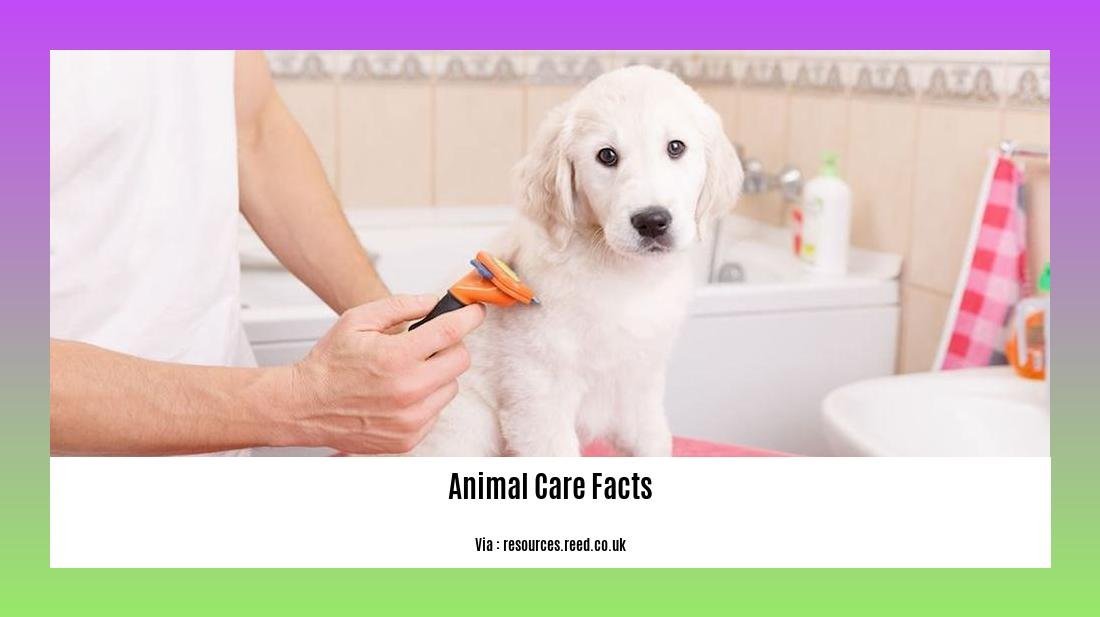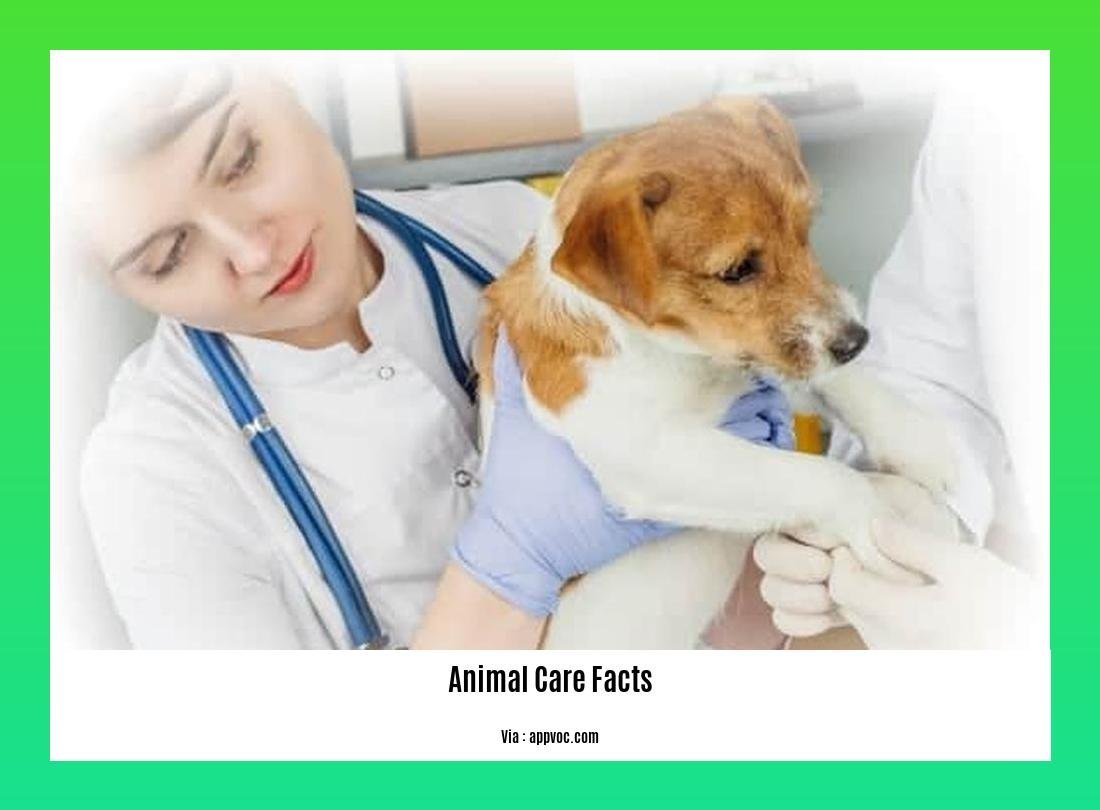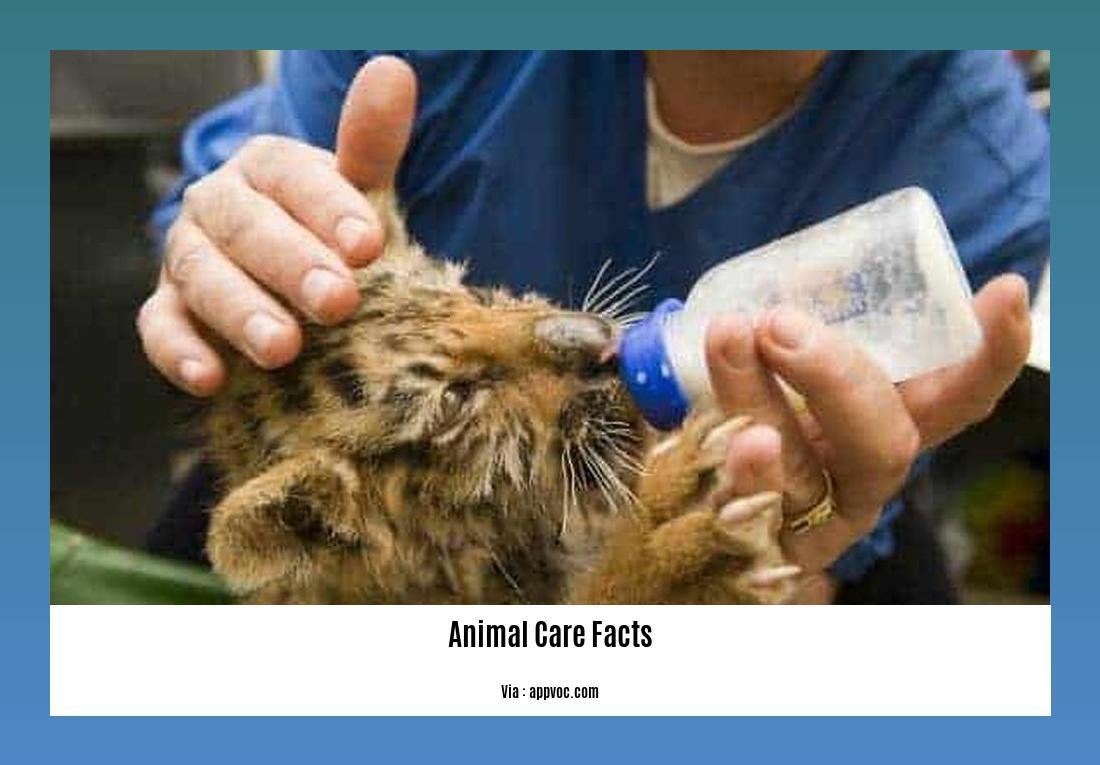Welcome to the fascinating world of animal care! In this article, we will delve into the realm of animal well-being, uncovering valuable facts and dispelling common myths that every pet owner should know. From funny anecdotes to enlightening discussions about animal care practices and facilities, we will explore the depths of this captivating subject. Whether you are a seasoned pet owner or just beginning your journey as a caregiver, this article aims to provide you with the knowledge and insights necessary to enhance the lives of your beloved animals. So, let us embark on this adventure of uncovering the truth behind animal care and facilities, as we strive to become more informed and compassionate guardians for our furry friends.
Key Takeaways:
1. Animal welfare encompasses various aspects such as disease prevention, veterinary treatment, shelter, nutrition, humane handling, and humane slaughter/killing.
2. Formal standards of animal welfare differ and are commonly debated by animal welfare groups, legislators, and academics.
3. Animal welfare science uses measures like longevity, disease, behavior, physiology, and reproduction to assess animal welfare, but there is ongoing debate about which indicators are most reliable.
4. Respect for animal welfare is rooted in the belief that nonhuman animals are sentient and deserve consideration for their well-being.
5. Concerns about animal welfare include the treatment of animals in food production, scientific experiments, captivity (zoos, farms, circuses), and the impact of human activities on wild species.
6. Criticisms of animal welfare come from two perspectives: some argue that humans have no duties or responsibilities towards animals, while others advocate for animal rights and reject any form of animal use by humans.
7. Animal welfare legislation and regulations vary globally, with the European Commission taking action in this area.
8. Animal welfare issues include animal testing, abandoned pets, anthropomorphizing animals (Bambi effect), and the implementation of behavioral enrichment techniques.
9. Different approaches and definitions exist in describing and defining animal welfare, with positive conditions often seen as indicators of good animal welfare.
Animal Care Facts

As a pet owner, it’s essential to have a solid understanding of animal care facts. By knowing these key aspects, you can ensure the well-being and happiness of your beloved pets. In this article, we will delve into some essential animal care facts that every pet owner should know.
The Role of Nutrition
Proper nutrition plays a vital role in maintaining your pet’s health and well-being. Offering a well-balanced diet that meets their specific dietary needs is crucial. Animal care fact: Different animals have different nutritional requirements, so it’s essential to provide them with food that is specifically formulated for their species. For example, dogs have different dietary needs than cats, and feeding them the wrong food can lead to nutritional deficiencies or health issues.
Regular Veterinary Care
Regular veterinary care is essential to ensure your pet’s overall health. Animal care fact: Just like humans, pets require regular check-ups and vaccinations to prevent diseases and maintain optimal health. Make it a habit to schedule routine visits with your veterinarian and follow their recommendations for vaccinations, parasite prevention, and dental care. Taking these proactive measures will help detect and address any potential health issues early on.
Exercise and Mental Stimulation
Physical exercise and mental stimulation are vital aspects of proper animal care. Animal care fact: Regular exercise helps prevent obesity, promotes good cardiovascular health, and improves overall well-being. Depending on the species and breed, pets require different amounts of exercise. For dogs, daily walks and play sessions are usually necessary. Cats, on the other hand, benefit from interactive toys and climbing structures. Providing mental stimulation, such as puzzle toys and training sessions, can be beneficial for both dogs and cats.
Socialization and Enrichment
Socialization and enrichment are crucial for pets to thrive. Animal care fact: Dogs and cats are social animals that require positive interactions with humans and other animals. Ensuring your pets have opportunities to meet and interact with others can help prevent behavioral issues and promote their overall happiness. Enrichment activities, such as providing toys, puzzles, and stimulating environments, are also essential to keep their minds engaged and prevent boredom.
Grooming and Hygiene
Maintaining proper grooming and hygiene practices is an important aspect of animal care. Animal care fact: Regular grooming helps keep your pet’s coat clean and healthy, preventing matting and skin issues. Brushing their teeth regularly, giving them baths when necessary, and trimming their nails are all necessary for their well-being. Additionally, make sure to use grooming products that are specifically formulated for your pet’s species to avoid any adverse reactions.
Safe Environment and Preventive Measures
Creating a safe environment for your pets is essential to protect them from potential hazards and accidents. Animal care fact: Pet-proofing your home and yard can go a long way in preventing injuries and keep your pets safe. Make sure to secure toxic substances, keep electrical cords out of reach, and remove any small objects that could be swallowed. Additionally, providing secure fencing and using leashes or harnesses during walks can prevent your pets from getting lost or injured.
The Power of Love and Attention
Lastly, never underestimate the power of love and attention in animal care. Animal care fact: Your pets thrive on your companionship and affection. Spending quality time with them, providing plenty of positive reinforcement, and offering a comfortable and loving environment are all vital for their overall well-being. Show your pets how much you care by giving them attention, playing with them, and ensuring they feel safe and loved.
Remember, being a responsible pet owner means continually educating yourself about animal care facts and staying up-to-date with the latest information. By doing so, you can provide the best possible care for your furry friends and ensure their long and happy lives.
Table: Pet Safety Tips
| Safety Tip | Description |
|---|---|
| Secure toxic substances | Keep all cleaning products, medications, and chemicals in a secure location out of your pet’s reach. |
| Remove small objects | Remove any small objects that pets could potentially swallow and cause choking or internal injuries. |
| Pet-proof your home | Identify and address any potential hazards in your home, such as electrical cords, open windows, or fragile items. |
| Provide a secure outdoor area | Ensure your yard is securely fenced to prevent your pets from wandering off or encountering any dangers. |
| Use leashes or harnesses | When taking your pets for walks, always use a leash or harness to keep them safe and prevent them from running into traffic or getting lost. |
Remember, always consult with your veterinarian for specific advice and guidance tailored to your pet’s individual needs.
In the fascinating world of aquatic creatures, did you know that there are some truly astonishing aquatic fun facts waiting to be discovered? Dive into the depths of knowledge and explore these captivating wonders of the sea. Learn more about the mesmerizing aquatic world by clicking here to unveil some intriguing aquatic fun facts.
Get ready to unravel the mysteries of the arctic as we unveil some surprising arctic willow facts. These remarkable facts about arctic willows will leave you in awe of their resilience and adaptation to the harsh arctic environment. Join us on this journey and click here to explore the captivating world of arctic willow facts.
Have you ever wondered if African wild dogs are related to dogs? These intriguing creatures not only have an uncanny resemblance to domestic dogs but also share some surprising connections. Unravel the truth and discover the fascinating relationship by clicking here.
Are you curious about the similarities between African wild dogs and hyenas? Dive into the world of African predators and uncover the surprising truth about their evolutionary history. Discover the intriguing connections by clicking here to explore the captivating relationship between African wild dogs and hyenas.
Myth-busting

Are you ready to separate fact from fiction when it comes to animal care? In this article, we’ll debunk some common myths and provide you with the truth behind these misconceptions. Get ready to be enlightened and empowered as a pet owner!
Myth 1: Farm Animals in the EU Use More Antibiotics than Humans
Fact: The latest 2021 JIACRA report published by the European Centre for Disease Prevention and Control (ECDC), the European Food Safety Authority (EFSA), and the European Medicines Agency (EMA) reveals that the use of antibiotics per kilogram of biomass is actually lower in farm animals compared to humans. Contrary to popular belief, farm animals in the EU do not consume more antibiotics than humans do.
Myth 2: Antibiotics are Used to Promote the Growth of Farm Animals in the EU
Fact: Another common misconception is that antibiotics are used to promote the growth of farm animals in the EU. However, this is not true. The use of antibiotics in farm animals is strictly regulated and is primarily aimed at treating and preventing diseases. The goal is to ensure the well-being and health of the animals, rather than enhancing growth.
Myth 5: Antibiotics are Present in Food
Fact: The presence of antibiotics in food is a concern for many people. However, strict regulations and testing protocols are in place to ensure that food products do not contain harmful levels of antibiotics. It is important to follow proper food handling and cooking practices to minimize any potential risks.
Myth 6: Intensive Farming Favors the Development of Antimicrobial Resistance
Fact: Intensive farming practices often face criticism, including the belief that they contribute to the development of antimicrobial resistance. While it is true that the misuse and overuse of antibiotics can lead to resistance, responsible antibiotic use and proper animal husbandry practices minimize this risk. Stringent regulations and monitoring help ensure the well-being of both animals and humans.
Myth 7: Antibiotics are Excessively Used in Animals by Non-Competent Persons
Fact: The use of antibiotics in animals is not left in the hands of non-competent individuals. Veterinarians play a crucial role in prescribing and overseeing the use of antibiotics in animals. They have the necessary expertise to ensure that antibiotics are used appropriately and in accordance with best practices.
Myth 10: We Have to Set a Target for Zero Use of Antibiotics in Animals
Fact: While reducing antibiotic use in animals is a goal, setting a target for zero use is not feasible or necessary. Antibiotics are a valuable tool in veterinary medicine, helping to treat and control diseases that can affect animal welfare. Responsible and judicious use of antibiotics, combined with preventive measures, is the key to maintaining animal health and well-being.
Key Takeaways:
- Contrary to myths, farm animals in the EU use fewer antibiotics than humans, as per the latest 2021 JIACRA report.
- Antibiotics in the EU are primarily used for treating and preventing diseases in farm animals, not for promoting growth.
- Strict regulations and testing protocols ensure that food products do not contain harmful levels of antibiotics.
- Responsible antibiotic use and proper animal husbandry practices in intensive farming minimize the development of antimicrobial resistance.
- Veterinarians play a vital role in overseeing the use of antibiotics in animals, ensuring competence and responsible use.
- While reducing antibiotic use is a goal, setting a target for zero use in animals is not practical or necessary.
Sources:
1. FVE – 10 myth busting facts about antibiotics and animals
2. EPRUMA – 11 Myth Busting Facts about Antibiotics and Animals
Animal Care and Facilities
Key Takeaways:
- Staffing is crucial in animal facility management, requiring well-trained personnel with expertise in animal care and veterinary care.
- Husbandry involves daily care, nutrition, hygiene, behavior monitoring, and proper housing for animals.
- Animal identification ensures accurate record-keeping and tracking of health and history.
- Working with hazards requires protocols to handle incidents like chemical spills or infectious diseases.
- Regular equipment maintenance, calibration, and safety measures are essential for a healthy environment.
- Animal procurement and transportation procedures prioritize safe and humane practices.
Animal care and facilities play a vital role in ensuring the well-being of animals and maintaining a safe environment for both animals and staff. Let’s delve into some key aspects of animal facility management.
Staffing: The Backbone of Animal Facility Management
Good staffing is the cornerstone of effective animal facility management. It involves having a skilled and qualified team to meet the needs of the animals. Adequate personnel ensures that the workload is manageable, with individuals possessing expertise in animal care, husbandry, and veterinary care.
Husbandry: The Well-being of Animals
Husbandry encompasses the day-to-day care and management of animals in the facility. It involves providing proper nutrition, maintaining cleanliness and hygiene, monitoring behavior and health, and ensuring suitable housing and environmental conditions. By addressing these aspects, husbandry plays a crucial role in promoting the well-being and health of animals.
Animal Identification: Accuracy and Record-Keeping
Each animal in the facility should have a unique identification number. Proper labeling or tagging ensures accurate record-keeping and simplifies tracking an individual animal’s health and history. This identification process is vital for research purposes and facilitates efficient management of animal populations.
Working with Hazards: Ensuring Safety
Animal facility management acknowledges the potential hazards involved. Facilities must have protocols and procedures in place to handle hazardous substances or situations. These protocols can include guidelines for dealing with chemical spills, infectious diseases, or other emergencies. Ensuring the safety of both animals and staff is of utmost importance.
Equipment Maintenance: A Healthy Environment
Proper maintenance and calibration of equipment are essential in animal facility management. Equipment such as cage washers, autoclaves, and environmental control systems should undergo regular maintenance to ensure their optimal performance. By maintaining the equipment, staff can provide a safe and healthy environment for the animals.
Safety Measures: Protecting All Involved
Animal facility management prioritizes the safety of animals, staff, and the facility itself. This involves maintaining safety equipment, such as personal protective gear, and ensuring that the facility is equipped with appropriate fire safety measures and emergency response plans. A comprehensive approach to safety safeguards all individuals and contributes to a secure working environment.
Animal Procurement: Safe and Humane Practices
Animal procurement is a critical aspect of animal facility management. Facilities should have established procedures to ensure the safe and humane transportation and acclimation of animals into the facility. By prioritizing the well-being of animals during the procurement process, facilities can maintain high standards of care.
In Conclusion
Animal facility management encompasses various critical areas, including staffing, husbandry, animal identification, working with hazards, equipment maintenance, safety measures, and animal procurement. Proper management in these areas is essential for maintaining the well-being of animals, ensuring accurate research data, and promoting a safe and healthy working environment for staff.
References:
- National Center for Biotechnology Information. (2018). Basic Animal Facility Management. Retrieved from
- National Center for Biotechnology Information. (2018). Animal Environment, Housing, and Management. Retrieved from
FAQ
Q1: Why is staffing important in animal facility management?
A1: Staffing is important in animal facility management because having a well-trained and qualified staff ensures the well-being of the animals. Proper staffing includes having enough personnel to handle the workload and having individuals with expertise in animal care, husbandry, and veterinary care.
Q2: What does husbandry involve in animal facility management?
A2: Husbandry in animal facility management involves the day-to-day care and management of animals. This includes providing proper nutrition, maintaining cleanliness and hygiene, monitoring behavior and health, and ensuring proper housing and environmental conditions.
Q3: Why is animal identification important in animal facility management?
A3: Animal identification is important in animal facility management because it allows for accurate record-keeping and tracking of individual animals’ health and history. Each animal should be properly labeled or tagged with a unique identification number.
Q4: What are some considerations for working with hazards in animal facility management?
A4: When it comes to working with hazards in animal facility management, facilities should have protocols in place to handle hazardous substances or situations. This includes having procedures for chemical spills, infectious diseases, and ensuring the safety of both animals and staff.
Q5: Why is equipment maintenance important in animal facility management?
A5: Equipment maintenance is important in animal facility management because it ensures a safe and healthy environment for the animals. Regular maintenance and calibration of equipment such as cage washers, autoclaves, and environmental control systems are crucial for maintaining the well-being of the animals.
- Crypto Quotes’ Red Flags: Avoid Costly Mistakes - June 30, 2025
- Unlock Inspirational Crypto Quotes: Future Predictions - June 30, 2025
- Famous Bitcoin Quotes: A Deep Dive into Crypto’s History - June 30, 2025
















